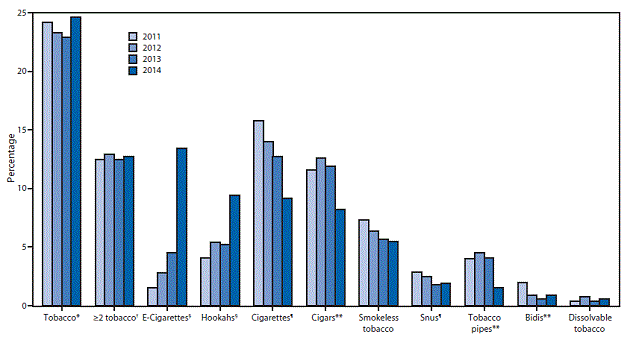
The CDC has hardly been friendly in its treatment of e-cigarettes. In 2013, they reported that youth use of e-cigarettes doubled from 2011 to 2012, with director Tom Frieden commenting that, “many teens who start with e-cigarettes may be condemned to struggling with a lifelong addiction to nicotine and conventional cigarettes.” In 2014, they reported that rates didn’t increase as much from 2012 to 2013, but the message was much the same, with the report claiming, “ever using a tobacco product is a concern because even one-time use of tobacco is associated with increased long-term risks for becoming a regular user.”
Now, in 2015, we’re treated to the next set of National Youth Tobacco Survey data, and despite spending the last few years continually harping on about the rising use of e-cigarette by youth and its potential as a gateway, the “concern” is growing less and less believable, as the data strongly suggests that e-cigarettes are in no way whatsoever serving as a gateway to smoking. “Current” vaping may have tripled, but smoking has declined dramatically.
The Results at a Glance
- The National Youth Tobacco Survey looks at use of various “tobacco products” by middle and high school students, counting “current use” as using one at least once in the past month.
- Current vaping has roughly tripled: going from 4.5 to 13.4 percent in high school students and 1.1 to 3.9 percent in middle school students from 2013 to 2014.
- From 2011 to 2014, vaping dramatically increased among youth – from 1.5 to 13.4 percent in high school and 0.6 to 3.9 percent in middle school students – and smoking has dramatically decreased – from 15.8 to 9.2 percent in high school and 4.3 to 2.5 percent in middle school students.
- From 2006 to 2009 (before vaping became popular), smoking rates decreased by an average of 0.367 percent per year for middle school and 0.867 percent per year for high school students, compared to an average annual decrease of 0.6 percent for middle school and 2.2 percent for high school students from 2011 to 2014, alongside the increase in vaping.
- Despite the rise in vaping, there has been no increase in nicotine use overall from 2011 to 2014, thoroughly undermining concerns of e-cigs serving as a gateway, especially when you consider the rapid declines in youth smoking.
The National Youth Tobacco Survey
The 2014 survey followed the same methodology as previous years, with the key point being that “current” use of cigarettes, e-cigarettes and the other studied products was defined as using on at least one day in the last 30. This is obviously not quite sufficient if you’re interested in regular use (would it be so difficult to ask about weekly or daily use?), but as long as you accept the likelihood that this will include some recent experimenters, it isn’t a huge issue. The survey goes out to middle school (grades 6 to 8) and high school (grades 9 to 12) students.
The Findings – Current E-Cigarette Use Triples Among Youth

The main widely-disseminated finding of the survey is that e-cigarette use among middle and high school students has tripled. From 2013 to 2014, current use of e-cigs among high school students went from 4.5 percent to 13.4 percent, and among middle school students it went from 1.1 to 3.9 percent. Cigarettes are generally falling out of favor, with just 9.2 percent of high school students having smoking in the past month (slightly less common than hookah use and substantially less common than vaping), and 2.5 percent of middle school students having done so (hookahs were just as popular, and again, vaping was more popular). No indication is given of how many e-cigarette users were current or ex-smokers, but in line with previous findings it would be expected to be almost all of them.
More Evidence that E-Cigarettes are a Gateway Away from Smoking for Youth
The most notable thing about the latest data is how dramatically it undermines claims that e-cigarettes are a gateway to tobacco use, or are going to have some other adverse effect on youth smoking. From 2011 to 2014, current vaping has skyrocketed in youth, rising from 1.5 to 13.4 percent in high school students and from 0.6 percent to 3.9 percent in middle school students. This is the source of much of the concern we’ve heard in recent years: “youths are increasingly using e-cigarettes,” we’re frequently warned. However, such statements are never placed into context with what is obviously the larger concern: youth smoking.
The unavoidable reality is that smoking rates have plummeted as vaping has become more popular, decreasing from 15.8 to 9.2 percent from 2011 to 2014 in high school students (with the percentage smoking decreasing at an average rate of 2.2 percent per year) and for middle school students it decreased from 4.3 percent in 2011 to 2.5 percent in 2014 (the smoking rate decreasing by 0.6 percent per year), overall a 42 percent decline in smoking in both high school and middle school students over three years.
Now, it’s entirely possible that this is just a coincidence; it could be that there are other explanations for the decline in smoking. The CDC itself argues, “Tobacco prevention and control strategies, including increasing tobacco product prices, adopting comprehensive smoke-free laws, and implementation of national public education media campaigns, might have influenced the reduction of cigarette smoking in youths.”
That’s true, it might have. However, such strategies are not a recent development. In fact, if they were really responsible for the impressive declines in smoking, we’d have been seeing similarly impressive declines for a while now. So what does the evidence say? Over the three years prior to the increase in popularity of e-cigarettes in the U.S., from 2006 to 2009, smoking rates in middle school students decreased from 6.3 to 5.2 percent, a (comparatively) measly reduction in the smoking rate by 0.367 percent per year, and for high school students, it declined from 19.8 to 17.2 percent, with the smoking rate decreasing by 0.867 percent per year. For middle school students, smoking is decreasing over 1.6 times faster from 2011 to 2014 than it had from 2006 to 2009, and for high school students it's over 2.5 times faster.

Well, someone might protest, that was just a bad few years for anti-youth-smoking efforts. But when you look at the annual decrease in smoking rates from 2000 to 2009, spanning a whole decade of data (and anti-smoking campaigns), smoking is still falling faster now. From 2000 to 2009, smoking rates among middle school students went down from 11 to 5.2 percent, with the smoking rate decreasing by 0.644 percent per year (actually a little faster than from 2011 to 2014), and for high school students it went from 28 to 17.2 percent, with the smoking rate decreasing by 1.2 percent per year. In short, vaping appears to be cutting youth smoking much faster than recent tobacco control efforts have. For middle school students the recent decrease is admittedly more in line with longer-term trends, but for high school students the difference is still quite a stark one: vaping really is helping. This explanation wasn’t even mentioned by the CDC.
Instead, by lumping e-cigarettes in with combustible cigarettes under the legal term “tobacco products,” they are claiming that the good work done elsewhere in reducing youth smoking (which has apparently magically become more effective in the past few years) is being offset by e-cigarettes. However, yet again, their own data really shoots them in the foot. The fact that they observed no significant change in the use of any tobacco product from 2011 to 2014 (from 24.2 to 24.6 percent for high school students) shows that nicotine use is about as prevalent as it’s ever been, but there has been a widespread switch from cigarette smoking to e-cigarettes – from the very harmful to the nowhere near as harmful.
If the “gateway effect” was true, and Tom Frieden’s warning in 2013 was valid, we’d have expected significant increases in nicotine use since e-cigarettes have increased in popularity, and, most likely, increases in smoking (or at least a slower decline) rather than the massive progress in reducing youth smoking that we’re seeing. Similarly, if e-cigarette use was encouraging use of multiple nicotine-containing products, as many like to claim, we’d see huge increases in use of two or more tobacco products, but that also hasn’t happened. In high school students, there has been no change in the rates of dual use, and for middle school students, it’s actually decreased from 3.8 percent to 3.1 percent.
The Actual Explanation: E-Cigarettes are Reducing Harm in Youth, Too
As more data comes from the National Youth Tobacco Survey, the alarmist suggestions based on the earlier evidence is being thoroughly put into context. Where Frieden called the rise in vaping “deeply troubling,” the evidence is increasingly showing that it represents a shift to less harmful products. We might like to stop youth from using any nicotine, but teens don’t really care what we might like, as evidenced by the fact that a lot of them smoke despite unavoidable messages about its dangers. However, the damage can be minimized, and it appears that it is. Over the last five years or so, vaping has become vastly more popular among youth, but smoking has declined much faster than it has in recent memory. Youths may be consuming nicotine as much as they did before, but they’re increasingly opting for the reduced-harm option over the definitively deadly one.
This was obvious anyway, which is likely why Frieden tried to wriggle out of having to say something positive by claiming that e-cigs would actually lead more youth to become addicted to nicotine, but every single year of data is undermining those ill-thought-out words. Cigarette smoking and nicotine addiction aren’t increasing, and the former (the most concerning) is actually decreasing at unprecedented rates, at least in high school students. Will we see a shift in attitude to accompany the increasingly compelling data suggesting that e-cigs are primarily responsible for rapid declines in youth smoking? I wouldn’t bet on it, because the “gateway” fears have never been supported by evidence, so being contradicted by it is unlikely to matter to anybody making unsubstantiated claims.

